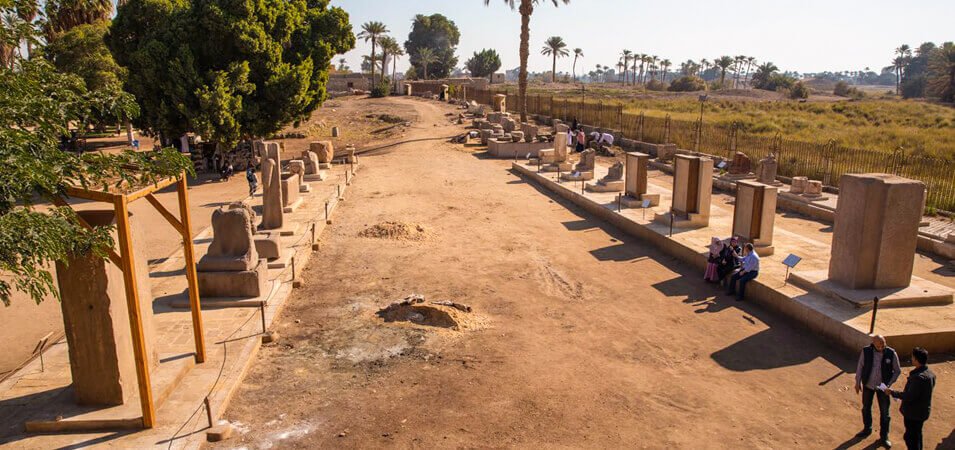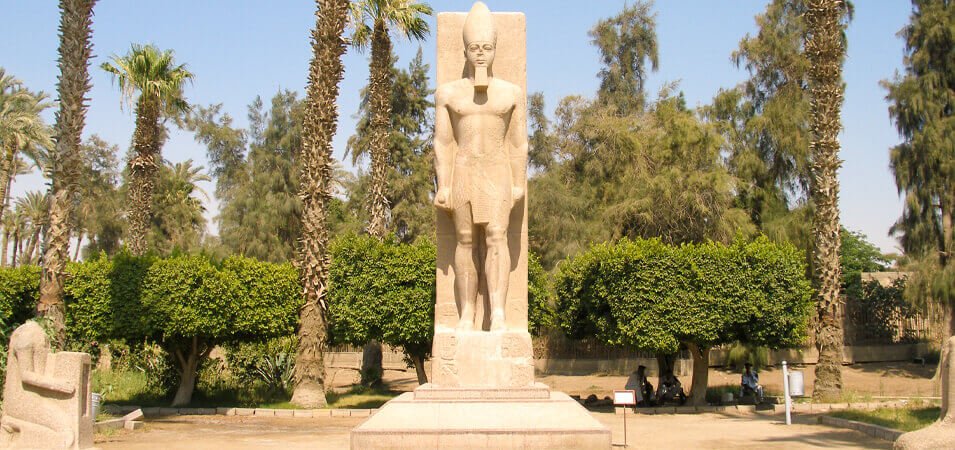The desert sands of Egypt, ever-shifting and ancient, hold within each grain the echoes of forgotten civilizations. These grains, witnesses to millennia of human achievement, now whisper the tales of two monumental cities: Memphis and Cairo. Each bathed in the golden glow of the Nile, these cities share a connection through their histories, yet they offer starkly different experiences. Memphis, the cornerstone of ancient Egyptian civilization, murmurs stories of pharaohs and deities, while Cairo thrums with the vibrant pulse of a city woven from a tapestry of cultures.
Separated by a mere 20 kilometers, Memphis and Cairo beckon travelers, history enthusiasts, and scholars alike to embark on a journey through time. This exploration will delve into the unique narratives of these ancient metropolises, revealing the treasures that await those who listen to their whispers.
Memphis: The Cradle of Egyptian Civilization
Memphis, nestled in the fertile expanse of the Nile Delta, traces its origins back to around 3100 BCE. This city holds the distinction of being the first unified capital of Ancient Egypt, traditionally credited to the founding pharaoh Menes, who united Upper and Lower Egypt. Originally called “Hut-ka-Ptah” (Enclosure of the Spirit of Ptah), Memphis swiftly rose to become a significant political and cultural hub.

The majestic white walls of the royal palace, as chronicled by ancient sources, symbolized the burgeoning power of the pharaohs. Memphis thrived during the Old Kingdom, witnessing the reigns of celebrated pharaohs like Djoser, the mastermind behind the Step Pyramid at Saqqara. This era was marked by a flourishing of art, architecture, and religion, with Memphis serving as the epicenter of worship for Ptah, the creator god in Egyptian mythology. The city’s rhythm was defined by grand ceremonies and elaborate rituals, cementing its status as the sacred and political heart of the ancient world.
Life in Memphis
- Memphis was a bustling city, a vibrant tapestry woven from the lives of diverse social classes. Here’s a glimpse into the social hierarchy and daily activities:
- The Elite: Resided in palatial estates adorned with intricate carvings and lush gardens, enjoying a life of luxury. Scribes meticulously documented daily affairs on papyrus scrolls, while skilled artisans crafted exquisite jewelry and statues.
- The Common People: Formed the backbone of the city, laboring in bustling workshops, fertile fields, and docks. Trade routes extended from Memphis, carrying papyrus, gold, and other precious commodities, transforming the city into a center of commerce and international exchange. Despite well-defined social hierarchies, opportunities for advancement existed, with skilled workers and talented artists rising through the ranks.
- Religious Life: Festivals were a cornerstone of life, uniting people from all walks of life in the celebration of gods and pharaohs. The city resonated with the clanging of metal from workshops, the rhythmic chants of priests, and the joyous laughter of families celebrating under the benevolent gaze of the Nile.
The Shifting Sands of Power: Memphis in Decline
Like all great empires, Memphis was not immune to the tides of change. The rise of Thebes during the Middle Kingdom (2052-1650 BCE) marked a significant shift in political power. Although still an important cultural and religious center, Memphis began to lose its status as the sole capital. The city’s fortunes further fluctuated with foreign invasions and internal strife.
- Middle Kingdom: The rise of Thebes diminished Memphis’s status as the capital.
- Foreign Invasions and Internal Strife: Eroded the city’s stability.
- Roman Era (30 BCE – 330 CE): Alexandria’s rise as a major port city overshadowed Memphis.
By the Roman era, the allure of Alexandria, a bustling port city founded by Alexander the Great, proved irresistible. Memphis gradually receded into the background, its grand structures succumbing to the relentless sands and the emergence of new architectural styles. Yet, the whispers of its past never truly died. The rediscovery of Memphis in the 19th century by archaeologists unearthed colossal statues of Ramses II and the sprawling necropolis with its majestic pyramids, revealing a treasure trove of knowledge about this ancient city. Today, Memphis stands as a vast open-air museum, a testament to its enduring legacy and a reminder that even the mightiest empires leave their stories etched in stone.
Choosing Your Ancient Adventure: Memphis vs. Cairo
Memphis and Cairo offer distinct travel experiences, each catering to different preferences. Here’s a guide to help you decide which ancient city beckons you most:
- Budget: Memphis is generally less expensive than Cairo, offering affordable accommodation and fewer crowds.
- Accessibility: Day trips from Cairo are readily available, making Memphis easily accessible. Independent exploration requires navigating public transportation.
- Best Time to Visit: Spring and fall provide pleasant weather, avoiding the scorching summer heat.
- Cultural Immersion: Memphis offers a glimpse into a bygone era, ideal for history buffs seeking a unique experience. Expect fewer tourist amenities compared to Cairo.
Whispers Through Time: A Final Enchantment
Memphis and Cairo stand as testaments to the enduring power of human civilization. Memphis, the cradle of pharaonic Egypt, beckons with its ancient ruins and forgotten stories. Cairo, a vibrant tapestry woven from countless cultures, pulsates with the energy of a living city. For travelers, these ancient giants offer a glimpse into bygone eras, a chance to walk where pharaohs once tread and marvel at architectural wonders that defy time. History enthusiasts will find themselves enthralled by the tangible echoes of the past, while students can delve into the rich tapestry of these timeless cities.

Unveiling the Past: Choosing Your Ancient Adventure
Memphis and Cairo provide distinct travel experiences, each catering to different preferences:
- Budget: Memphis is generally more affordable than Cairo, with cheaper accommodation and fewer crowds.
- Accessibility: Day trips from Cairo make Memphis easily accessible, though independent exploration requires navigating public transportation.
- Best Time to Visit: Spring and fall offer pleasant weather, avoiding the extreme heat of summer.
- Cultural Immersion: Memphis offers a unique glimpse into a bygone era, ideal for history enthusiasts seeking an authentic experience. Tourist amenities are less prevalent compared to Cairo.
FAQs
Why is Memphis called Egypt?
Memphis is not called Egypt. Rather, Memphis is an ancient city in Egypt. It served as the capital of ancient Egypt during the Old Kingdom (circa 2686–2181 BC) and remained an important city throughout ancient Egyptian history. Memphis is located near the modern city of Cairo.
What is Memphis called in Arabic?
In Arabic, Memphis is called (pronounced “Manf”).
Who is the god named Memphis?
There is no god named Memphis. However, Memphis was closely associated with the god Ptah, who was considered the city’s patron deity. Ptah was the god of craftsmen and architects and played a central role in Memphis’s religious life.
What was Cairo called in ancient times?
Cairo, known in Arabic as القاهرة (Al-Qāhirah), was not established until the 10th century AD. In ancient times, the area where modern Cairo is located had several different names and settlements. The ancient city of Heliopolis (ancient Egyptian: Iunu, Greek: Ἡλιούπολις) was one of the most significant settlements near the area. However, Cairo as it is known today did not exist in ancient Egyptian times.
What is the greatest treasure found in Egypt?
The greatest treasure found in Egypt is often considered to be the tomb of Tutankhamun (King Tut), discovered by archaeologist Howard Carter in 1922. The tomb, located in the Valley of the Kings, was filled with a vast array of treasures, including the famous gold mask of Tutankhamun, jewelry, chariots, and other artifacts. These treasures provide invaluable insights into ancient Egyptian civilization and the wealth and craftsmanship of the New Kingdom period.
